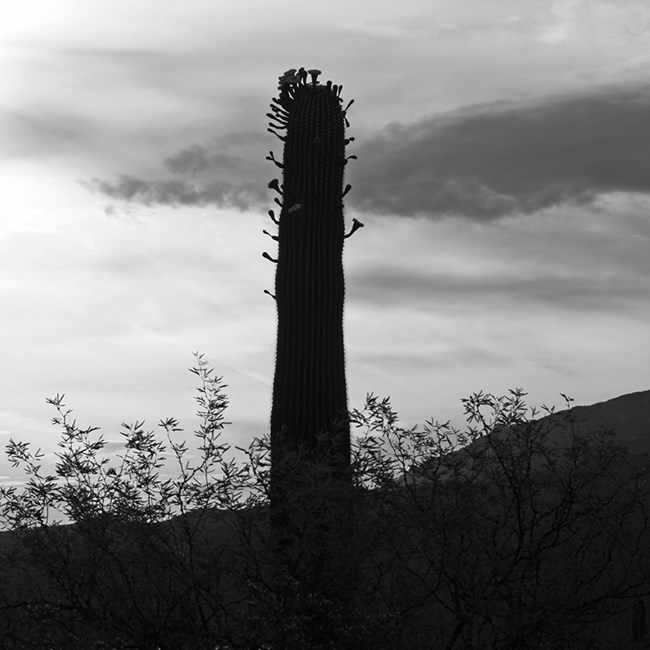Last updated: February 17, 2022
Article
The Extraordinary Saguaro Bloom of 2021: An Explanation

NPS/Tani Hubbard
Sonoran Desert residents witnessed an extremely rare phenomenon in the spring of 2021: saguaro blooms were literally busting out all over. Saguaros typically bloom in spring. And when they do, the blooms are usually confined to a crown at the very top of the main body or mature arms. But after an unseasonal bloom in fall 2020, saguaro flowers in May 2021 appeared down the length of main stems and arms, and—remarkably—even on small buds (“nubbins”). See more photos
The summer of 2020 brought Tucson its hottest summer and second-driest monsoon on record—on top of years of regional drought—leading some longtime observers to hypothesize that the extraordinary bloom was a stress response. But the longer climate record may hold some interesting clues, as well.
According to Saguaro National Park biologist Don Swann, a big surge in recruitment in the 1960s through the early 1990s means a lot of saguaros are starting to reach reproductive age at Saguaro National Park. But recruitment has dramatically declined in the past 25 years or so, coincident with long-term drought. The 2020 saguaro census did find some young saguaros in a few places in the park—mostly in places where soils likely retain more moisture than elsewhere.
In fact, the more we learn about soil moisture, the more important it appears to be for plant productivity. So what is soil moisture?
Soil moisture is a measure of how much water is available for plants to use. It operates on a longer timescale than monthly or even seasonal precipitation. Put simply, the soil is a bank account for water. And like your bank account limits what you can pay for, soil moisture limits how much plants can grow in arid environments. Plants don’t “drink” rain; they use water from soil taken up by their roots. By calculating water balance, we can estimate how much precipitation is actually available to plants. Starting with the total precipitation, we subtract runoff, drainage, and evapotranspiration. The remaining water, stored in soil, can be used by plants.

Annual amount of soil moisture and Normalized Difference Vegetation Index (NDVI, an analogue for plant productivity) at a site on the Cactus Forest Loop Drive, 2001-2021. The point where the two arrows come together represents a “pivot point” where the critical water amount needed to sustain average vegetation condition is met. To the right of that point, soil moisture exceeds what’s needed to meet the basic needs of plants. To the left, it fails to meet that need.
The figure above shows the relationship between soil moisture and plant productivity at a site on the Cactus Forest Loop Drive for the month of April over the past 20 years. The R2 value of 0.88 shows that the soil-moisture values “explain” 88% of the variability in plant productivity. The relationships with other climate variables, such as precipitation and temperature, are not nearly as strong.
In this case, plant productivity in April is strongly tied to the amount of moisture held in the soil during that month—which is the balance of what accumulated over winter and what was used already in the spring leading up to the month of April.
Long-lived plants, like saguaros, are responsive to long-term conditions—more so than, say, an annual brome, whose entire life cycle occurs over the course of a single year. This is because conditions in prior years set the stage for vegetation growth in the current year. As with animals, reproduction is a costly endeavor in plants. It takes energy to make flowers and seeds that contain the energy needed for seedling establishment. Long-lived species take many years to mature—and even then, several years of resource accumulation may be needed for reproduction.
Could it be that it takes a few good years to build up the reserves needed for a masting event (massive seed production) in saguaros, just as it does with many tree species? Look again at the figure above and note that even though April 2021 was notably dry, 2019 and 2020 were well above the “pivot point” where the critical water amount needed to sustain average vegetation condition is met (this is akin to the 8 glasses of water per day typically needed for optimal human function). So even though April 2021 was unusually dry, the stage may have been set in prior years for the impressive bloom in 2021.

NPS/Tani Hubbard
We don’t have definitive answers yet. But in the meantime, the Sonoran Desert Network’s partnership with the Climate Analyzer will make it possible for park managers to know if/when the kinds of climate conditions that led up to this year’s bloom occur in the future. By coding this bloom—or any other ecological anomaly—as a significant event, the Climate Analyzer can be set to send a notification if climate conditions similar to those that led up to it are detected in the future. Tracking events like this can help determine if the bloom is closely tied to climate conditions—and importantly, which climate conditions are important (hint: in this case, it may be April soil moisture!).
Whether this current reproductive profusion results in widespread saguaro recruitment will depend on what happens next. Early summer rains, followed by a continued cooler and wetter period of a couple of years, are key to producing a cohort of saguaros. We know this because of long-term monitoring programs like Saguaro National Park’s decennial saguaro census.
